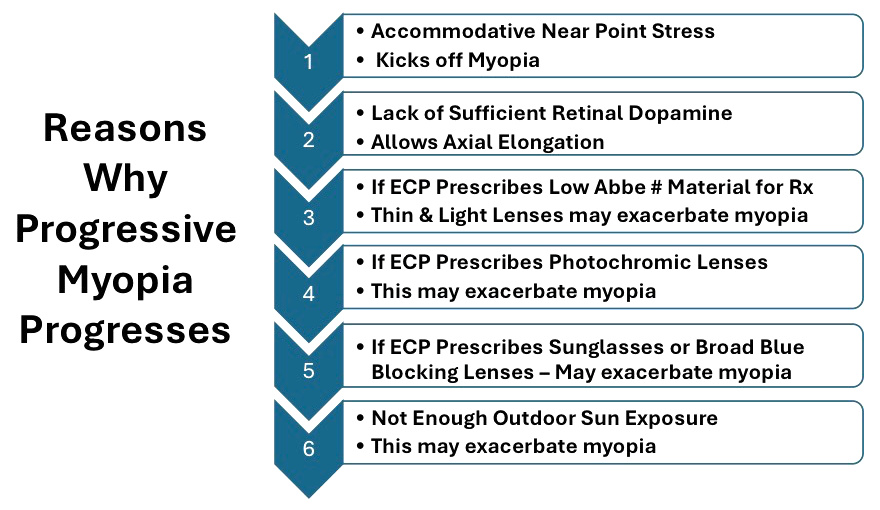Juvenile-onset myopia (nearsightedness) occurs due to accommodative near point stress that generates a force causing an increase in the axial length of the eye. The resulting axial elongation occurs when the eye’s ocular structure is unable to provide an offsetting force equal to or larger than that of the force causing axial elongation. The weakness of the opposing ocular structural is due to a deficiency of dopamine present in the retina. Ample retinal dopamine is required to increase choroid thickness and maintain a healthy sclera, both of which generate an offsetting force of resistance to axial elongation of the eye.
While there is a healthy scientific debate regarding which of the photoreceptors is most important with regards to the production of retinal dopamine, NeuroRays™ believes it is the retinal rods. https://pubmed.ncbi.nlm.nih.gov/30799247/
It is our belief that the following cascading events occur which then cause myopia. Also, by the utilization of optogenetics it is possible to slow, if not, stop myopia progression.
Myopia = Near point accommodative Stress > Choroidal Thinning > Scleral Hypoxia > Scleral Thinning > Axial Elongation
NeuroRays™ Solution = Blue Light Wavelengths 475nm +/- 20nm Targets Retinal Rods > Increases Retinal Dopamine > Releases Nitric Oxide a Vasodilator > Promotes Choroidal Blood Flow > Increases Choroidal Thickness> Releases Additional Retinoic Acid (RA) > Causes Scleral Remodeling > Provides a Healthier Sclera > Slows or Stops Myopia Progression.
Several factors can exacerbate childhood myopia and cause myopia progression. These include continued near point stress, lack of ample beneficial blue light striking the retina, lack of ample dopamine production, and correcting a child’s vision with spectacle lenses comprised of materials having a significant amount of longitudinal chromatic aberration.
Why could lens materials having significant longitudinal chromatic aberration contribute to myopia progression? A well-accepted measure for the longitudinal chromatic aberration (LCA) in a transparent material is the Abbe number. The higher the Abbe number, the less dispersion, i.e. less LCA as the light passes through the material. The human eye has a blended Abbe number of 54. Certain references even compute the human eye Abbe number at 47. Thus, any material with an Abbe number of less than 54, (more conservatively an Abbe of 47), has a greater LCA than the human eye. (See listing of lens materials on page 3). The human eye has an LCA of approximately 2.00D on the high end. Thus, lenses comprising a lens material having an Abbe # that is less than 47 – 54 “may” cause more LCA than can be accommodated by the human eye to maintain the clearest vision possible. For example, when children wear spectacles comprised of materials having low Abbe numbers in the 30s, the eye’s accommodative system may be under increased (if not constant) stress due to the significant LCA generated by the lenses.
The accommodative system of the human eye is mainly controlled by the ciliary muscle. A 2024 peer-reviewed paper stated that the ciliary body is responsible for the axial elongation of the eye. https://pubmed.ncbi.nlm.nih.gov/38626193/ If the corrected myopic eye continues to be under accommodative stress due to LCA, the eye is more prone to axial elongation which causes myopia progression.
By increasing the production of retinal dopamine in the eye it is possible to increase choroid thickness, cause scleral remodeling and end up with a healthier and stronger sclera. https://pubmed.ncbi.nlm.nih.gov/35447101/ The net result being an improved ocular structure of the eye capable of offsetting some or all of the axial elongation force. Thus, slowing down or stopping myopia progression.
Outdoor sunlight and certain indoor lighting can help facilitate the generation of dopamine in the eye. Beneficial blue light wavelengths of 475nm +/- 20nm generate dopamine in the eye and possibly the brain. Lenses and activities that reduce ample blue light from striking the retina should be contraindicated for myopes aged 20 or below. Examples would be today’s sunglasses, photochromatic lenses, low levels of outdoor activity, and broad blue blocking lenses. In addition, lenses with an Abbe number of less than 47 should be contraindicated as well, given that such lenses “may” increase the near point accommodative stress of the wearer.

It is important to note that this white paper represents the current thoughts of NeuroRays™ as it relates to the genesis of Myopia and Myopia progression and NeuroRays™ proprietary solution for slowing or stopping myopia progression. As more research is enacted this hypothesis may change or solidify.
References
Light, Rods, Dopamine
Victor Perez-Fernandez, Nina Milosavljevic, Annette E. Allen, Kirstan A. Vessey, Andrew I. Jobling, Erica L. Fletcher, Paul P. Breen, John W. Morley, and Morven A. Cameron, Rod Photoreceptor Activation Alone Defines the Release of Dopamine in the Retina, Current Biology 29, 763–774, 2019, https://doi.org/10.1016/j.cub.2019.01.042
Eye choroid and sclera
Jing Yang et al., Advances in biomedical study of the myopia-related signaling pathways and mechanisms, Biomedicine & Pharmacotherapy 145 (2022) 112472
Douglas G McMahon, John E Dowling, Neuromodulation: Actions of Dopamine, Retinoic Acid, Nitric Oxide, and Other Substances on Retinal Horizontal Cells, Eye and Brain 2023:15 125–137
Jost B. Jonas, et al., Myopia: Anatomic Changes and Consequences for Its Etiology, Asia-Pacific Journal of Ophthalmology Volume 8, Number 5, September/October 2019, https://journals.lww.com/apjoo
Jing Yang et al., Advances in biomedical study of the myopia-related signaling pathways and mechanisms, Biomedicine & Pharmacotherapy 145 (2022) 112472
Josh Wallman, Jonathan Winawer, Homeostasis of Eye Growth and the Question of Myopia, Neuron, Vol. 43, 447–468, August 19, 2004.
Angelica R. Harper, Jody A. Summers, The Dynamic Sclera: Extracellular Matrix Remodeling in Normal Ocular Growth and Myopia Development, Exp Eye Res. 2015 April; 133: 100–111.
Chuanxu Li et al., All-trans retinoic acid regulates the expression of the extracellular matrix protein fibulin-1 in the guinea pig sclera and human scleral fibroblasts, Molecular Vision 2010; 16:689-697
Brown DM, Kowalski MA, Paulus QM, et al. Altered structure and function of murine sclera in form-deprivation myopia. Invest Ophthalmology Vis Sci. 2022;63(13):13. https://doi.org/10.1167/iovs.63.13.13
Backhouse S, Gentle A, 2018. Scleral remodeling in myopia and its manipulation: a review of recent advances in scleral strengthening and myopia control. Ann. Eye Sci 3, 5–5. 10.21037/ aes.2018.01.04
Dillon M. Brown et al., Candidate pathways for retina to scleral signaling in refractive eye growth, Exp Eye Res. 2022 June; 219: 109071. Doi: 10.1016/j.exer.2022.109071.
Hao Wu et al., Scleral hypoxia is a target for myopia control, PNAS | vol. 115 | no. 30 | E7091–E7100
Ute Mathis et al., Studies on the interactions of retinal dopamine with choroidal thickness in the chicken, Graefe’s Archive for Clinical and Experimental Ophthalmology (2023) 261:409–425
Yilin Liu et al., The influence of choroid on the onset and development of myopia: from perspectives of choroidal thickness and blood flow, Acta Ophthalmology. 2021: 99: 730–738
Jody A. Summers Rada and Lisa Palmer, Choroidal Regulation of Scleral Glycosaminoglycan Synthesis during Recovery from Induced Myopia, Investigative Ophthalmology & Visual Science, July 2007, Vol. 48, No. 7.
Boote C, Sigal IA, Grytz R, Hua Y, Nguyen TD, Girard MJA, 2020. Scleral structure and biomechanics. Prog. Retin. Eye Res 74, 100773. 10.1016/j.preteyeres.2019.100773 [PubMed: 31412277]
Simon Backhouse, Alex Gentle, Scleral remodeling in myopia and its manipulation: a review of recent advances in scleral strengthening and myopia control, Ann Eye Sci 2018;3:5
Debora L. Nickla et al., Nitric Oxide Synthase Inhibitors Prevent the Growth-inhibiting Effects of Quinpirole, Optom Vis Sci. 2013 November; 90(11): 1167–1175. doi:10.1097/OPX.0000000000000041
Shen, Ling MD; You, Qi Sheng MD; Xu, Xiaolin MD; Gao, Fei MD; Zhang, Zhibao MD; Li, Bin MD; Jonas, Jost B. MD. SCLERAL AND CHOROIDAL THICKNESS IN SECONDARY HIGH AXIAL MYOPIA. Retina 36(8): p 1579-1585, August 2016. | DOI: 10.1097/IAE.0000000000000947
Simon Backhouse, Alex Gentle, Scleral remodeling in myopia and its manipulation: a review of recent advances in scleral strengthening and myopia control, Ann Eye Sci 2018; 3:5.
Retinioic acid, retinoids and eye
Andreazzoli, M.; Longoni, B.; Angeloni, D.; Demontis, G.C. Retinoid Synthesis Regulation by Retinal Cells in Health and Disease. Cells 2024, 13, 871. https://doi.org/10.3390/cells13100871
Duester, G. Towards a Better Vision of Retinoic Acid Signaling during Eye Development. Cells 2022, 11, 322. https://doi.org/ 10.3390/cells11030322
Brian Thompson et al., Genetics and functions of the retinoic acid pathway, with special emphasis on the eye, Human Genomics (2019) 13:61
Palczewski, K.; Kiser, P.D. Shedding new light on the generation of the visual chromophore. Proc. Natl. Acad. Sci. USA 2020, 117, 19629–19638.
Choi, E.H.; Daruwalla, A.; Suh, S.; Leinonen, H.; Palczewski, K. Retinoids in the visual cycle: Role of the retinal G protein-coupled receptor. J. Lipid Res. 2021, 62, 100040.
Isla-Magrane, H. et al. All-trans retinoic acid modulates pigmentation, neuroretina maturation, and corneal transparency in human multilocular organoids. Stem Cell Res. Ther. 2022, 13, 376
Sanjurjo-Soriano, C.; et al. Retinoic acid delays initial photoreceptor differentiation and results in a highly structured mature retinal organoid. Stem Cell Res. Ther. 2022, 13, 478.
Kelley, R.A.; Chen, H.Y.; Swaroop, A.; Li, T. Accelerated Development of Rod Photoreceptors in Retinal Organoids Derived from Human Pluripotent Stem Cells by Supplementation with 9-cis Retinal. STAR Protoc. 2020, 1, 100033
Rastinejad, F. Retinoic acid receptor structures: The journey from single domains to full-length complex. J. Mol. Endocrinol. 2022, 69, T25–T36.
Telias et al., Retinoic Acid Induces Hyperactivity, and Blocking Its Receptor Unmasks Light Responses and Augments, Vision in Retinal Degeneration2019, Neuron 102, 574–586
Elliot H. Choi et al., Thematic Review Series: Seeing 2020: Lipids and Lipid-Soluble Molecules in the Eye Retinoids in the visual cycle: role of the retinal G protein-coupled receptor, J. Lipid Res. (2021) 62 100040 PETER MCCAFFERY et al., Light-mediated retinoic acid production, Proc. Natl. Acad. Sci. USA, Vol. 93, pp. 12570-12574, October 1996
